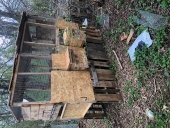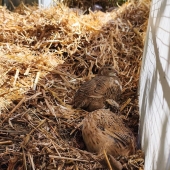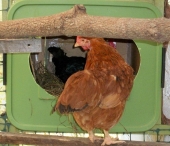

 6
6






- Tim's Homestead Journal - Purchase a copy of Building a Better World in Your Backyard - Purchase 6 Decks of Permaculture Cards -
- Purchase 12x Decks of Permaculture Cards - Purchase a copy of the SKIP Book - Purchase 12x copies of Building a Better World in your Backyard
 7
7




"When the whole world is running towards a cliff, he who is running in the opposite direction appears to have lost his mind." C.S. Lewis
Visit https://themaineingredient.com for organic, premium dried culinary herbs that are grown, processed, and packaged in the USA.
 6
6




"The one small garden of a free gardener was all his need and due, not a garden swollen to a realm; his own hands to use, not the hands of others to command." -Samwise Gamgee, J.R.R. Tolkien
 9
9




Suzette Thib wrote:I always purchased mine. I much preferred straw but it comes a long way to get to Louisiana and wasn't always available. The pine we had access to had some little flying insects in it and they bothered the hens mightily. Winters of heavy rain on clay soil just wasn't ideal for chickens, to be honest. I haven't seen a non-sloppy method this far South. Something I never tried but would in theory, is pine needles. In our garden, the pine needles have a tough enough consistency that they don't fall apart like straw, also a pleasant smell. Good luck!
A build too cool to miss:Mike's GreenhouseA great example:Joseph's Garden
All the soil info you'll ever need:
Redhawk's excellent soil-building series

















 4
4




Trace Oswald I tried pine needles and didn't like them at all. Like leaves, pine needles don't absorb anything and mat together. They are also very hard to scoop up and get out of the coop once they mat together in a big clump.
- Tim's Homestead Journal - Purchase a copy of Building a Better World in Your Backyard - Purchase 6 Decks of Permaculture Cards -
- Purchase 12x Decks of Permaculture Cards - Purchase a copy of the SKIP Book - Purchase 12x copies of Building a Better World in your Backyard
 6
6




 9
9




https://againfarmstead.com/ | @againandagainfarmstead
 8
8




"The genius of American farm experts is very well demonstrated here: they can take a solution and divide it neatly into two problems." -Wendell Berry
 9
9




"The genius of American farm experts is very well demonstrated here: they can take a solution and divide it neatly into two problems." -Wendell Berry
 4
4




This is all just my opinion based on a flawed memory








 4
4




 5
5




Josh Hoffman wrote:I bag 2 acres of grass
Zone 9b




Juniper Zen wrote:
Josh Hoffman wrote:I bag 2 acres of grass
Just a warning for those who are unaware - some chickens will eat a bunch of grass at once and end up with an impacted crop. Make sure they have free access to grit. If you regularly check on your chickens, especially in the morning, you'll be more likely to notice a problem before it gets serious. (An impacted crop will still be full and hard in the morning before the chicken eats anything. Normally the crop should empty overnight.)
I am actually writing this with a chicken on my lap, whom I am nursing back from the brink of death. It took me too long to notice her impacted crop - I've been overwhelmed with work - and she had already lost too much weight and was dehydrated. Cross your fingers I'm able to pull her through.
"The genius of American farm experts is very well demonstrated here: they can take a solution and divide it neatly into two problems." -Wendell Berry
 6
6




 6
6




Josh Hoffman wrote:This chicken you are referring to ate too much grass? In a coop or tractored or free range?
 But while I was researching impacted crops, I came across stories of other people's chickens having eaten too much long grass and it getting twisted up and stuck in the crop. Obviously that doesn't usually happen, but I just wanted to let readers know about the possible risk so that they can watch out for it and intervene if they see a problem.
But while I was researching impacted crops, I came across stories of other people's chickens having eaten too much long grass and it getting twisted up and stuck in the crop. Obviously that doesn't usually happen, but I just wanted to let readers know about the possible risk so that they can watch out for it and intervene if they see a problem.Zone 9b
 7
7




Invasive plants are Earth's way of insisting we notice her medicines. Stephen Herrod Buhner
Everyone learns what works by learning what doesn't work. Stephen Herrod Buhner

 2
2




How Permies works: https://permies.com/wiki/34193/permies-works-links-threads
My projects on Skye: The tree field, Growing and landracing, perennial polycultures, "Don't dream it - be it! "
 3
3




Nancy Reading wrote:I like the idea of deep leaves on top of mesh floors. Although I don't keep chickens (yet) I worry that the wire would be hard on their feet.
"When the whole world is running towards a cliff, he who is running in the opposite direction appears to have lost his mind." C.S. Lewis
Visit https://themaineingredient.com for organic, premium dried culinary herbs that are grown, processed, and packaged in the USA.
 3
3





















- Tim's Homestead Journal - Purchase a copy of Building a Better World in Your Backyard - Purchase 6 Decks of Permaculture Cards -
- Purchase 12x Decks of Permaculture Cards - Purchase a copy of the SKIP Book - Purchase 12x copies of Building a Better World in your Backyard
 3
3




 2
2




Juniper Zen wrote:
Josh Hoffman wrote:This chicken you are referring to ate too much grass? In a coop or tractored or free range?
My chicken passed away today, and a necropsy showed that the underlying problem was that her gizzard was full of tumors.But while I was researching impacted crops, I came across stories of other people's chickens having eaten too much long grass and it getting twisted up and stuck in the crop. Obviously that doesn't usually happen, but I just wanted to let readers know about the possible risk so that they can watch out for it and intervene if they see a problem.
Moderator, Treatment Free Beekeepers group on Facebook.
https://www.facebook.com/groups/treatmentfreebeekeepers/





 2
2




Moderator, Treatment Free Beekeepers group on Facebook.
https://www.facebook.com/groups/treatmentfreebeekeepers/






| I agree. Here's the link: http://stoves2.com |






